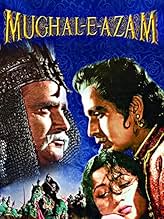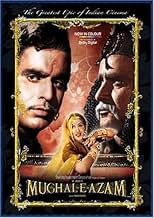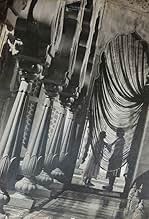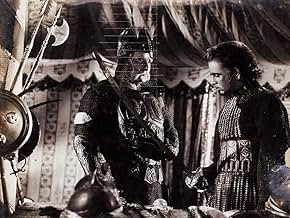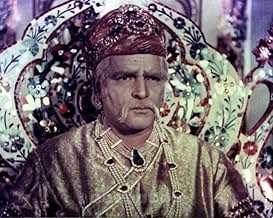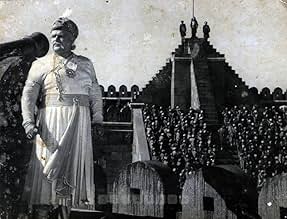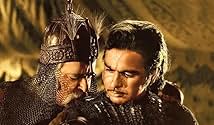CALIFICACIÓN DE IMDb
8.1/10
9.3 k
TU CALIFICACIÓN
Agrega una trama en tu idiomaA 16th century prince falls in love with a court dancer and battles with his emperor father.A 16th century prince falls in love with a court dancer and battles with his emperor father.A 16th century prince falls in love with a court dancer and battles with his emperor father.
- Premios
- 3 premios ganados y 3 nominaciones en total
Prithviraj Kapoor
- Emperor Akbar
- (as Prithviraj)
Ajit Khan
- Durjan Singh
- (as Ajit)
Jillo
- Anarkali's Mother
- (as Jillo Bai)
Sheila Dalaya
- Suraiya
- (as Sheela Delaya)
Tabassum Govil
- A Tawaif
- (as Baby Tabassum)
Opiniones destacadas
Some films are popular only in their own time and some films continue to fascinate successive generations that is the essential difference between a good film and a classic one Mughal-e-Azam
The ostentatious look, the unforgettable music, the awesome war scenes, superb performances, the well-known romance between Salim and Anarkalis MUGHAL-E-AZAM will always remain as a point of reference.
After 44 years, this masterpiece has been released after reviving it in color (the original version was 85 percent black and white and 15 percent colour), with an upgraded, contemporary sound system (Dolby Digital).
The Story is about the Ruler Akbar (Prithviraj Kapoor) and Queen Jodha (Durga Khote) give birth to a son, Salim, after years of prayer.
Prince Salim (Dilip Kumar) grows into a commendable combatant. Salim falls in love with court dancer Anarkali (Madhubala). Initially wary of his affections because of the difference in their positions, she soon reciprocates his love.
Akbar finds out about the affair and that creates a rift between the father and son.
It is a must see movie for every moviegoer for its pure canvass, for its majestic framing and not just for being a colorful costume drama, for its romance, for the glorious Sheesh Mahal and also for our fake filmmakers (like karan johar, aditya chopra, nikhil advani, kunal kohli and many others like them) who cannot think beyond Manhattan and singing heroes and have light years to reach this level of film-making.
MUGHAL-E-AZAM is a must for those who have seen it in B & W. Now watch it in color and experience the grandeur. MUGHAL-E-AZAM is a must for todays generation, who, perhaps, may not have watched this classic. Watch this epic and you will realize the difference between the cinema of yore and the cinema of today. MUGHAL-E-AZAM is a must for every moviegoer. Here is a prime example of pure, unadulterated cinema. 4 ½ Out of 5
After 44 years, this masterpiece has been released after reviving it in color (the original version was 85 percent black and white and 15 percent colour), with an upgraded, contemporary sound system (Dolby Digital).
The Story is about the Ruler Akbar (Prithviraj Kapoor) and Queen Jodha (Durga Khote) give birth to a son, Salim, after years of prayer.
Prince Salim (Dilip Kumar) grows into a commendable combatant. Salim falls in love with court dancer Anarkali (Madhubala). Initially wary of his affections because of the difference in their positions, she soon reciprocates his love.
Akbar finds out about the affair and that creates a rift between the father and son.
It is a must see movie for every moviegoer for its pure canvass, for its majestic framing and not just for being a colorful costume drama, for its romance, for the glorious Sheesh Mahal and also for our fake filmmakers (like karan johar, aditya chopra, nikhil advani, kunal kohli and many others like them) who cannot think beyond Manhattan and singing heroes and have light years to reach this level of film-making.
MUGHAL-E-AZAM is a must for those who have seen it in B & W. Now watch it in color and experience the grandeur. MUGHAL-E-AZAM is a must for todays generation, who, perhaps, may not have watched this classic. Watch this epic and you will realize the difference between the cinema of yore and the cinema of today. MUGHAL-E-AZAM is a must for every moviegoer. Here is a prime example of pure, unadulterated cinema. 4 ½ Out of 5
When one thinks of great movies they remember the classics such as gone with the wind, Ben hur etc... but let us not forget one of the greatest cinematic triumphs of Hindi Cinema Mughal-e-Azam a film set in the times of the great Moughul Empire. Having seen both the part B/W and Colour and the remastered full colour version I can truly say that the colourised version truly brings out the true glory of this amazing classic putting it in a league way beyond the Classics of today. The dialogue is simply superb and the acting truly amazing modern filmmakers could learn thing or two about acting. The cinematography is simply stunning for a movie of its time. the grandeur and opulence of the sets really comes out in full colour. The story though not very relevant for modern times shows the views and attitudes of India's past. a truly great film to watch...
I haven't seen the black and white original of Mughal E Azam since the '80's, but I recently saw the restored revived colourised 2004 re-release for the first time and was astounded by the results. I'm not a believer in messing around with the originals, but bearing in mind director Asif always wanted to make the whole film in colour but didn't have enough money the "final" product is amazing to see - such is technology! It was incredibly expensive to make as it was, the restoration process must have cost a fabulous amount too.
Seminal Indian epic purporting to deal with events from about 400 years ago around Prince Saleem (Dilip Kumar) falling in love with a court dancer Anarkali (Madhubala) to his father Akbar's utter opposition and eventually causing a rift leading to all out war. The drama and war spectacle scenes are memorable enough, with thousands of humans and animals as extras, and the music is uniformly superb too. But it's Pyar Kiya To Darna Kya (If I have loved someone>why should I be afraid?) sung by Anarkali (Lata) to the 2 of them in the Hall Of Mirrors that is absolutely stunning - I will have to get the original and compare, because the remaster seems to have turned this song into something even more magical and mesmerising than I remembered. It took Naushad and Shakeel Badayuni one night to compose music and lyrics so timeless - a colourful piece of poetry in motion, with the insistent kaleidoscopic climax added by Asif. Awesome! According to the legend it was supposed to have an unhappy ending - needless to say I'm glad it was altered here to a happy one after such a roller-coaster ride!
A tremendous work of Art, showing the very best of Indian cinema.
Seminal Indian epic purporting to deal with events from about 400 years ago around Prince Saleem (Dilip Kumar) falling in love with a court dancer Anarkali (Madhubala) to his father Akbar's utter opposition and eventually causing a rift leading to all out war. The drama and war spectacle scenes are memorable enough, with thousands of humans and animals as extras, and the music is uniformly superb too. But it's Pyar Kiya To Darna Kya (If I have loved someone>why should I be afraid?) sung by Anarkali (Lata) to the 2 of them in the Hall Of Mirrors that is absolutely stunning - I will have to get the original and compare, because the remaster seems to have turned this song into something even more magical and mesmerising than I remembered. It took Naushad and Shakeel Badayuni one night to compose music and lyrics so timeless - a colourful piece of poetry in motion, with the insistent kaleidoscopic climax added by Asif. Awesome! According to the legend it was supposed to have an unhappy ending - needless to say I'm glad it was altered here to a happy one after such a roller-coaster ride!
A tremendous work of Art, showing the very best of Indian cinema.
Mughul-E-Azam boasts of some of the highest production values employed in filmmaking in India up to that point, and the result is astounding, to say the least. The film is a true cinematic experience in terms of aesthetics, and be it the black-and-white or the colour version, it is an unforgettable visual treat. The sets, the costumes, are stunningly lavish, almost to the point of casting a gloom over the story itself. And then we have the story, an epic, poetic one, which involves a most subtle love story. The dialogue is stupendous, with many lines having a memorable, larger-than-life quality which enhances the narrative beyond imagination. The music is similarly fantastic, with spectacularly performed dance numbers. Needless to say, "Pyar Kiya To Darna Kya" is the high-point of the film and the story it tells. Prithviraj Kapoor is excellent in a wonderfully dramatic and appropriately theatrical performance as Emperor Akbar. Dilip Kumar seems to enjoy his own, mere presence, while underplaying his role to great effect. It is Madhubala, however, who walks away with the most fully-realised part of Anarkali, a slave girl whose dignity cannot be taken away at any cost. I found the film a greatly entertaining watch, and while I had a problem with its overlong running time, as well as some faulty sequences, such as the less convincing battle between the father and son, Mughul-E-Azam remains a meticulous piece of art, and a rightly-touted all-time classic of Indian cinema.
¿Sabías que…?
- TriviaThe song "Pyar Kiya To Darna Kiya" has an unusual history to it: it cost Rs. 10 million at a time when a film would be made for less than a million; it was written and re-written 105 times by the lyricist, Shakeel Badayuni, before the music director, Naushad, could approve of it; it was shot in the renowned Sheesh Mahal (Palace of Mirrors); and in those days of sound recording, editing and mixing, as there was no way to provide the reverberation of sound, Naushad had playback singer Lata Mangeshkar sing the song in a studio bathroom.
- ErroresMusic and dancing styles from the 19th century were depicted, although the story takes place in the 16th century. For example, Thumri, a semi-classical music form developed in the 19th century, is adopted in a dance sequence in Kathak style, which is a 16th-century dance form.
- Créditos curiosos2004: The End Credits play the song 'Pyaar Kiya To Darna Kya' and its 1960 end credits are adjacent to the 2004 (Technicians) credits.
- Versiones alternativasThe original version is in B/W and only one song 'Pyar kiya to darna kya...' was shot in color as most of the film (by the time color technology was available) was complete. This was at the end of almost 10 years that the film was being completed. However, the year 2004 re-release is re-mastered from the original B/W version to Color with Dolby Digital sound and some visual enhancements.
- ConexionesFeatured in Century of Cinema: And the Show Goes On: Indian Chapter (1996)
Selecciones populares
Inicia sesión para calificar y agrega a la lista de videos para obtener recomendaciones personalizadas
- How long is Mughal-E-Azam?Con tecnología de Alexa
Detalles
Taquilla
- Presupuesto
- INR 15,000,000 (estimado)
- Total en EE. UU. y Canadá
- USD 161,434
- Fin de semana de estreno en EE. UU. y Canadá
- USD 60,258
- 3 abr 2005
- Total a nivel mundial
- USD 161,434
- Tiempo de ejecución3 horas 17 minutos
- Color
- Mezcla de sonido
- Relación de aspecto
- 1.37 : 1
Contribuir a esta página
Sugiere una edición o agrega el contenido que falta

Principales brechas de datos
What is the Spanish language plot outline for Mughal-E-Azam (1960)?
Responda

